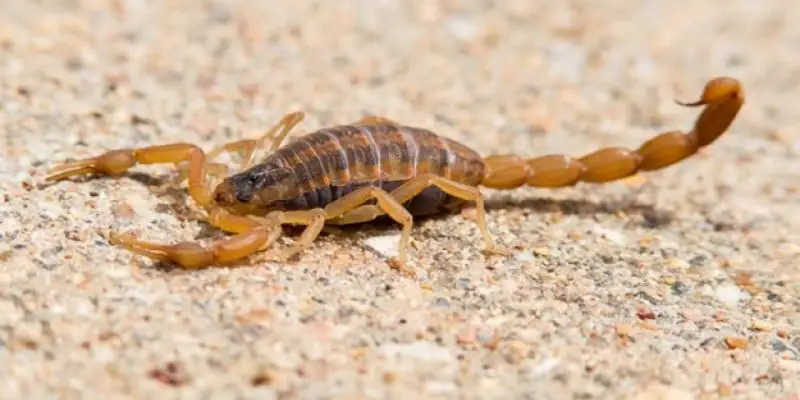When the Arizona desert cools after sunset, a world unseen during the day begins to awaken. The sand darkens, the air settles, and shadows stretch across saguaros and red-rock slopes. Somewhere between those shadows, a tiny creature with an ancient lineage begins to move—silent, precise, and often completely invisible unless a UV beam happens to catch its glowing silhouette. This is the Arizona bark scorpion, an animal as feared as it is misunderstood.
To many residents and newcomers, bark scorpions are simply pests—creatures that sneak into shoes, climb up walls, or, in the worst cases, surprise sleeping homeowners. Yet beneath those urban encounters lies an animal shaped by millions of years of evolution, crafted into one of the most adaptable, intelligent, and ecologically important predators in the American Southwest. The bark scorpion is not just a threat to avoid but a fascinating biological marvel worth understanding.
This comprehensive guide reveals the hidden truths behind Arizona’s most iconic arachnid. You’ll learn how bark scorpions survive extremes that would kill most animals, why they glow under ultraviolet light, how they navigate the desert with astonishing accuracy, and why they sometimes appear inside homes even when homeowners do everything right. Alongside the biological and behavioral insights, you’ll also find practical safety tips and prevention strategies, allowing you to appreciate the creature while still protecting your living space.
Understanding the Arizona Bark Scorpion

The bark scorpion (Centruroides sculpturatus) holds a unique place in the desert ecosystem. Although small—usually around 2.5 inches from head to stinger—it has earned a massive reputation. Its venom is the most medically significant of all scorpions in the United States, and yet, the species is among the most fragile members of the Southwest’s wildlife community.
Physical Appearance and Key Features
Bark scorpions are slender and lightweight, making them far more agile than the Arizona desert hairy scorpion or stripe-tailed scorpion. Their narrow pincers and elongated tail give them a delicate look, almost fragile compared to other species. Their color—ranging from pale yellow to warm tan—acts as a natural camouflage against tree bark, desert soil, and stucco walls.
One of their most remarkable features is the glowing effect under UV light. Because their exoskeleton contains a substance called beta-carboline, they transform into radiant blue-green silhouettes when exposed to ultraviolet rays. Scientists still debate the evolutionary purpose of this fluorescence, but it is one of the easiest ways to identify bark scorpions during nighttime searches.
Range and Distribution Across Arizona
Arizona is the heartland of the species. Bark scorpions thrive in:
-
Phoenix and the surrounding metropolitan desert
-
Tucson and the Sonoran foothills
-
The Verde Valley
-
Southern Arizona basin regions
-
Mountain foothills with sufficient shade and humidity
These creatures also live in New Mexico, Nevada, and parts of Utah and Mexico, but Arizona hosts the largest and healthiest populations due to the ideal combination of habitat, heat, and humidity.
Natural Habitat and Micro-Regions
While many scorpions prefer the ground, the bark scorpion is semi-arboreal. It seeks out trees, fallen logs, shady rock crevices, abandoned burrows, and other cool, protected spaces. In wild environments, they often choose:
-
Mesquite and cottonwood groves
-
Desert washes with occasional moisture
-
Cliffs, boulders, and stony slopes
-
Shaded canyon corridors
Their ability to flatten themselves allows them to slip into unbelievably narrow spaces, using cracks and bark layers to shield themselves from Arizona’s intense sunlight.
Behavior That Makes Them So Fascinating
Nocturnal Precision
Bark scorpions become active only at night. Their bodies lack the ability to regulate water loss effectively, meaning exposure to direct sun or dry heat for too long can quickly dehydrate and kill them. To survive, they hide inside shaded spaces and emerge when temperatures drop. Under the nighttime calm, they hunt with remarkable finesse, detecting prey through vibrations in the ground.
Sensory Superpowers
The bark scorpion’s body is covered in microscopic sensory hairs called trichobothria. These hairs can detect minute changes in air movement, the low hum of insect wings, or the slightest shifting of sand grains. Their world is a complex mesh of invisible signals, none of which humans can perceive.
Their compound eyes, although not sharp, are incredibly sensitive to light. Even moonlight provides enough illumination for them to detect shapes and movement, and starlight alone can guide their steps.
Surprising Social Structure
Most arachnids lead solitary lives, but bark scorpions break that rule. During colder months, they gather in communal clusters, sometimes with 20 to 40 individuals huddled in a single crevice. This group behavior helps them maintain warmth and survive winter nights that would otherwise drop below their comfort level. The instinct to group together hints at a complexity that many people would never expect from these creatures.
Sting Control and Venom Conservation
Contrary to common fears, bark scorpions do not sting impulsively. They control their venom use carefully. A “dry sting”—a sting without venom—is often used as a warning or when the scorpion feels slightly threatened. Venom is conserved for hunting and true emergencies. This behavior demonstrates intelligence and resourcefulness rather than mindless aggression.
Hidden Facts About Bark Scorpions in Arizona
Bark scorpions possess several abilities that seem almost unbelievable until you learn how they work.
They Can Survive Being Underwater
By tightly closing their spiracles—the small openings used for breathing—bark scorpions can survive underwater for more than 24 hours. This adaptation allows them to endure flash floods, irrigation mishaps, and unexpected moisture events common in Arizona.
They Give Birth to Live Babies
Unlike insects, bark scorpions give birth to live young. A typical litter includes 20–35 scorplings. Newborn scorpions are pale and fragile, clinging tightly to their mother’s back for protection. They remain there until their first molt, which occurs after one to two weeks, forming the start of an independent life.
They Can Pause Their Metabolism
In harsh conditions, bark scorpions can drastically reduce their metabolic rate, allowing them to survive extended periods without food—sometimes several months. This adaptation helps them endure drought periods when prey becomes scarce.
They Navigate Using Earth’s Vibrations
Trichobothria allow bark scorpions to detect subtle ground vibrations, enabling them to determine the size, direction, and distance of approaching animals. To a bark scorpion, the desert surface is like a living map constantly sending signals.
They Glow for Mysterious Reasons
Although scientists understand how bark scorpions glow, why they glow is still debated. Some theories include:
-
A form of protection from UV radiation
-
A way to enhance night vision
-
Communication with other scorpions
-
A leftover chemical trait from ancient ancestors
Whatever the reason, the glow remains one of the most mesmerizing traits of the species.
The Arizona Diet: What Bark Scorpions Eat
What They Eat in the Wild
Bark scorpions primarily consume:
-
Crickets
-
Beetles
-
Small spiders
-
Silverfish
-
Centipede juveniles
-
Occasionally other smaller scorpions
When hunting, they rely on their sensory hairs to detect prey movements. With precise timing, they strike quickly, using venom to immobilize prey before feeding.
Their Urban Diet
In urban areas, bark scorpions feed on pest insects that thrive around homes. These include roaches, crickets, earwigs, and even baby geckos. Because of this, bark scorpions inadvertently help keep insect populations in check.
What Attracts Them to Homes
Factors attracting bark scorpions include:
-
Irrigation and moisture
-
Shade and cool landscaping areas
-
Insect populations around porch lights
-
Rock gardens, wood piles, and debris
-
Gaps in foundations or roof tiles
Where insects thrive, scorpions naturally follow.
Reproduction and Life Cycle
Courtship Ritual
Courtship between bark scorpions is a carefully choreographed dance involving the male grasping the female’s pincers as he guides her across the ground in search of a suitable surface for sperm transfer. This dance can last minutes or hours.
Birth and Development
After gestation, the mother gives birth to live scorplings, which immediately climb onto her back. After their first molt, they venture out and begin independent lives. They molt several times before reaching full maturity, and adults can live five to seven years or more under stable conditions.
Habitats Across Arizona
Desert Washes and Rocky Terrain
These areas offer moisture pockets and shady hiding spaces. In desert washes, insects are plentiful, making them ideal hunting grounds.
Riparian Forests
Along rivers such as the Gila, Salt, and Verde, bark scorpions flourish in cool, damp environments with abundant prey.
Suburban Neighborhoods
Modern Arizona communities provide unintended scorpion habitat through irrigation, rock landscapes, and lush vegetation.
Inside Homes
Scorpions enter homes via:
-
Door gaps
-
Window frames
-
Utility pipes
-
Roof spaces
-
Stucco cracks
Their flattened bodies make even the smallest gap an open invitation.
Why Bark Scorpions Enter Homes
Seeking Shade and Moisture
Extreme heat drives scorpions into cool, sheltered indoor spaces.
Following Food Sources
Insects inside homes attract bark scorpions searching for an easy meal.
Accidental Entry
Many scorpions accidentally wander inside while climbing trees, walls, or outdoor structures.
Dangers and Safety Concerns
The Painful Sting
The sting of a bark scorpion is intensely painful, producing:
-
Sharp burning sensations
-
Tingling or numbness
-
Temporary paralysis of affected limbs
-
Muscle twitching
-
Difficulty breathing in severe cases
Modern antivenom and medical care make severe outcomes extremely rare.
Pets and Scorpions
Cats may hunt scorpions instinctively, while dogs tend to get stung more often. Most pets recover with rest, though vet care may be needed for sensitive animals.
When to Seek Medical Attention
Go to the ER if:
-
A young child is stung
-
The victim has difficulty breathing
-
Severe muscle twitching occurs
-
Symptoms last longer than 4–6 hours
Preventing Bark Scorpions From Entering Homes
Seal Entry Points
Use weather stripping, silicone caulk, and door sweeps to block gaps.
Control Insects
Fewer insects lead to fewer scorpions. Yellow “bug lights” can help reduce insect activity around entry doors.
Yard Maintenance
Remove debris, trim vegetation, and keep wood piles away from the home’s foundation.
Safety Habits
Always:
-
Shake out clothing and shoes
-
Use gloves when handling outdoor materials
-
Keep beds away from walls
-
Check cribs for potential entry points
Myths and Misconceptions About Bark Scorpions
Myth |
Truth |
|---|---|
Bark scorpions attack humans. |
They avoid confrontation. |
They jump or pounce. |
They cannot jump. |
All scorpions in Arizona are deadly. |
Only the bark scorpion has significant venom. |
Blacklights attract them. |
Blacklights simply reveal them. |
You can drown a scorpion easily. |
They can survive underwater for 24+ hours. |
Frequently Asked Questions (FAQ)
Are bark scorpions common in Arizona?
Yes. They are widespread in central and southern regions, especially in actively irrigated areas.
What time are bark scorpions most active?
Warm nights—especially above 80°F—bring peak activity.
Can bark scorpions climb walls?
Yes. Their claws allow them to grip rough surfaces like stucco and bark.
Do bark scorpions glow naturally?
They glow under UV light due to chemicals in their exoskeleton.
How long do bark scorpions live?
They typically live 5–7 years, sometimes longer.
Do they enter homes often?
They enter homes seeking moisture, insects, shade, or accidentally.
Are they aggressive?
No. They prefer to flee unless cornered.
What should I do if stung?
Clean the area, use a cool compress, and monitor symptoms. Seek medical help for children or severe reactions.
Final Thoughts
The Arizona bark scorpion is a creature of contrasts—feared yet fragile, venomous yet ecologically vital, secretive yet widespread. It embodies the adaptability and resilience of desert wildlife. Understanding its behavior, survival strategies, and role in the environment can transform fear into respect. With proper precautions and awareness, it’s possible to coexist safely with one of the Southwest’s most fascinating and misunderstood animals.






